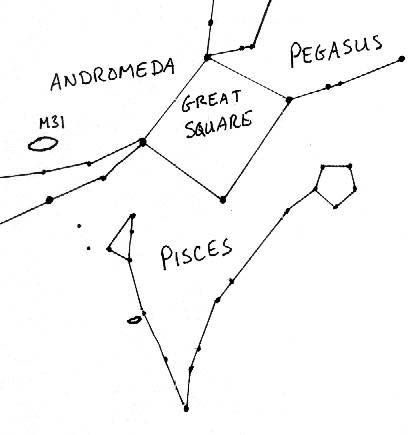In legend, these two fishes are Venus and Cupid, the mother-and-son love doctors of the ancient world. Giant monster Typhon breathed fire, and when he charged Olympus, all of the gods changed into animal forms to facilitate a quick departure. Venus and her son, knowing that fiery Typhon could not tolerate water, changed themselves into fishes, tied together by a silver cord so they would not be separated, and dove into the sea. Eventually, Typhon was captured and imprisoned beneath the earth, he became the source of earthquakes and volcanoes.
 The cord still connects the two fishes in the night sky. Pisces makes a large V shape, some 25 degrees on each side, below the bottom point of the Great Square in the eastern sky. By 9:00 PM you should be able to see all of the constellation if you have a clear eastern view. By the end of October, when daylight saving time has ended, Pisces will be visible at dusk.
The cord still connects the two fishes in the night sky. Pisces makes a large V shape, some 25 degrees on each side, below the bottom point of the Great Square in the eastern sky. By 9:00 PM you should be able to see all of the constellation if you have a clear eastern view. By the end of October, when daylight saving time has ended, Pisces will be visible at dusk.At the left, or eastern, end of the cord, below the mid-section of Andromeda, is a small triangular grouping representing one of the fish. On the western, Pegasus, side is a lopsided hexagon representing the other fish. This group of stars is also referred to as the Circlet.
Like its predecessors in the zodiac, Pisces is not a bright constellation. There is a spiral galaxy, M74, very near the brightest star on the eastern arm, but even it is faint. It requires a moderately large telescope and dark skies, and even with that, it is still challenging to observe.
Once again, it is the early risers who get the best action this month. On the morning of October 17, look for the waning gibbous moon near Saturn.

The Piker Press moderates all comments.
Click here for the commenting policy.